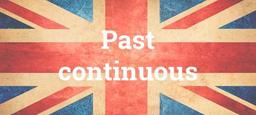
Past Continuous Tense
Quiz by Yorman Vasquez
Feel free to use or edit a copy
includes Teacher and Student dashboards
Measure skillsfrom any curriculum
Measure skills
from any curriculum
Tag the questions with any skills you have. Your dashboard will track each student's mastery of each skill.
With a free account, teachers can
- edit the questions
- save a copy for later
- start a class game
- automatically assign follow-up activities based on students’ scores
- assign as homework
- share a link with colleagues
- print as a bubble sheet
8 questions
Show answers
- Q1What is the past tense of the verb to be? (¿Cual es el pasado del verbo to be?)Am / Is / AreBeenWas / WereBe45s
- Q2What is a gerund? (¿Que es un gerundio?)English verb ending in -ed (Verbo en ingles que termina en -ed)English verb ending in -ing (Verbo en ingles que termina en -ing)English verb that is in its base form (Verbo en ingles que esta en su forma base)45s
- Q3This verb tense is usually used to describe a continuous event that occurred in the past. (Este tiempo verbal suele utilizarse para describir un evento continuado que ocurrió en el pasado)Present Perfect Continuous/ ProgressivePresent Continuous/ProgressivePast Perfect Continuous/ ProgressivePast Continuous/Progressive45s
- Q4Joe twisted his ankle while I was coming in home. Is in Past Continuous? (Joe se torció su tobillo mientras yo entraba a la casa. ¿Esta en pasado continuo?)TrueFalse45s
- Q5What is the difference between past continuous and present continuous? (¿Cual es la diferencia entre pasado continuo y presente continuo?)Present continuous expresses actions in the moment. Past Continuous expresses actions repeated in the past. (Presente continuo expresa acciones en el momento. Pasado Continuo expresa acciones repetidas en el pasado).Present continuous expresses habits and customs. Past Continuous expresses places of origin. (Presente continuo expresa habitos y costumbres. Pasado Continuo expresa lugares de origen).45s
- Q6How Negative Form is formed in the Past Continuous? (¿Cómo se Forma negativa en el Pasado Continuo?)[Subject] + auxiliary verb "to be" + not + [Verb in gerund] [Sujeto] + verbo auxiliar “to be” + not + [Verbo en gerundio][Subject] + auxiliary verb "to be" in past + not + [Verb in gerund] ([Sujeto] + verbo auxiliar “to be” + not + [Verbo en gerundio])[Subject] + auxiliary verb "did" + not + [Verb in gerund] [Sujeto] + verbo auxiliar “did” + not + [Verbo en gerundio]45s
- Q7You were not following the instructions. Is it in the Present Simple?FalseTrue45s
- Q8Verbs that are NOT used in the past continuous: (Verbos que NO se usan en pasado continuo: Los verbos de emociones) Emotion verbs: believe, doubt, want, understand, understand, wish.TrueFalse45s